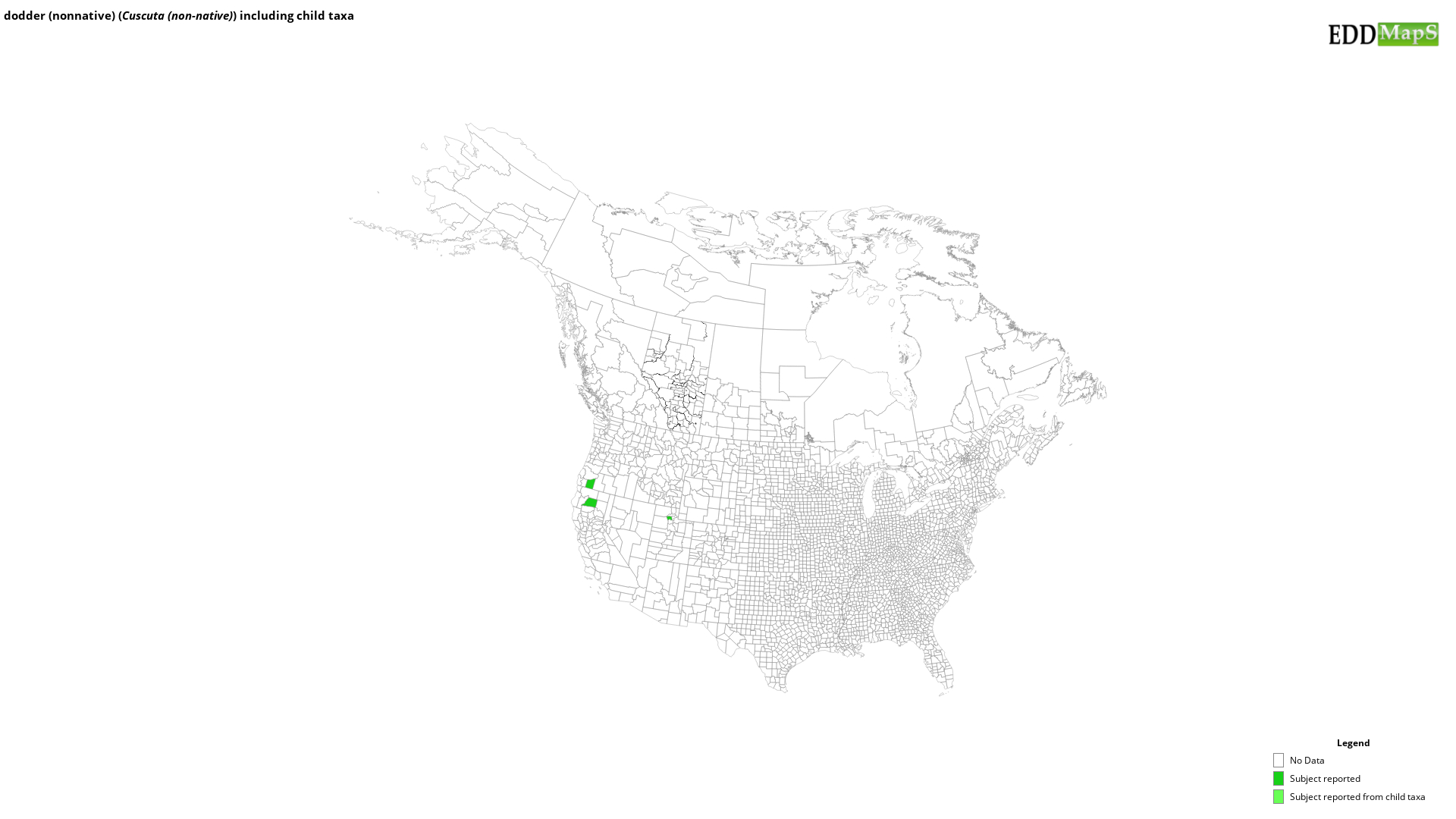dodder (nonnative)
(Cuscuta (non-native))
This species is Introduced in the United States
Overview:
Dodder is a parasitic annual plant that infests many crops, ornamentals, native plants, and weeds. There are many species – both native and introduced. Dodder has slender, twining, thread-like stems that vary in color from pale-green to yellow or bright orange, depending on the species, which may be leafless or have small scales. Seed germinates at or near the soil surface and sends up a stem to coil around any object. When the stem contacts a host plant, it develops small structures called haustoria which penetrate the host’s vascular tissue. Dodder is capable of limited photosynthesis, but gets nearly all of its energy from the host plant, extracting nutrients and water. Dodder seedlings must adhere to a host plant in 5-10 days or they will die. Seedlings have no root and lose contact with the soil once attachment is made to a host plant. As dodder plants grow, they continually re-attach to the host plant, and shoots spread to nearby host plants, eventually forming a dense mat of intertwined stems. Dodder seeds have an extremely hard coat, requiring scarification and can remain viable in the soil for up to 20 years in optimum environmental conditions. Dodder acts as an alternate host for some viral plant diseases. The twining stems tangle in harvesting equipment, resulting in seed spread.
Habitat
Dodder appears well adapted to cultivated situations and succeeds with many crops. Growth is greatly reduced in shaded areas.
Identification:
Stems: Stems are slender, threadlike, pale-green, yellow, or orange twining stems coil around forbs and shrubs. They adhere to host plants with wart-like suckers called haustoria.
Leaves: Leafless or small, triangular scales about 1-2 mm long.
Flowers: Tiny, bell-shaped white or cream flowers, about 3 mm long, and usually clustered.
Seed: Seed pods are rounded capsules, containing 1-4 tiny, rough seeds, about 2 mm in size.
Prevention:
Early detection is important. Parasitic dodder seeds can be moved with infested soil and water runoff but are also spread when harvested and transported with crops, such as hay, or on ornamentals. Thoroughly clean equipment, tools, and footwear before leaving infested areas. Do not transport dodder-infested materials and forage to other areas.
Control:
Grazing: Not applicable.
Cultivation: Avoid using host plants in gardens & landscaping where possible, or rotate with non-host plants. Infected plants can be pruned – cut at least 0.5 cm below the point of attachment.
Mechanical: New infestations can easily be controlled before attachment by hand-pulling, cultivation or mowing. After attachment, host plants must be cut below the point of attachment and all dodder and debris thoroughly burned or bagged and properly disposed of before seeds ripen. Burning dodder-infested material will destroy the plant and some of the seeds, depending on the severity of the fire. Repeated tillage can exhaust the seed bank if no host plants are present.
Chemical: Glyphosate is registered for use on Dodder. Always check product labels to ensure the herbicide is registered for use on the target plant in Canada by the Pest Management Regulatory Agency. Always read and follow label directions. Consult your local Agricultural Fieldman or Certified Pesticide Dispenser for more information.
Biological: None researched to date.
Maps
EDDMapS Distribution - This map is incomplete and is based only on current site and county level reports made by experts, herbaria, and literature. For more information, visit www.eddmaps.org
State Lists - This map identifies those states that have this species on their invasive species list or law.
Invasive Listing Sources
Taxonomic Rank
| Domain: Eukarya |
| Kingdom: Plantae |
| Phylum: Magnoliophyta |
| Class: Magnoliopsida |
| Superorder: Asteranae |
| Order: Solanales |
| Family: Convolvulaceae |
| Genus: Cuscuta |
| Cuscuta (non-native) |


